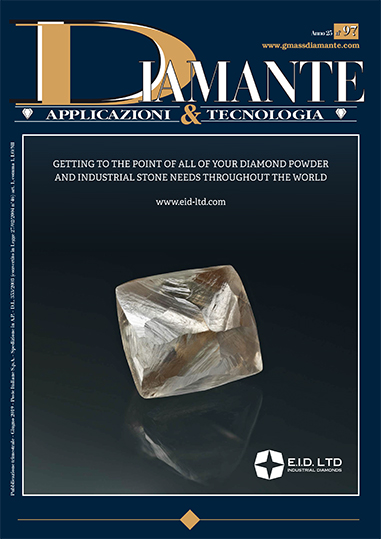|
Diamante A&T Contents Year XXV - June 2019 |
|||||
|
Front Cover: EID LTD For more than 50 years EID has been providing the widest array of top quality industrial diamond stones, natural and synthetic diamond powders to the trade. In the Spotlight 08) Marmomac 2019 - Veronafiere: the natural stone business is increasingly digital and international 22) 5th International Conference on powder metallurgy in Asia Diamond Tools 17) Phases of the diamond tools production process by B. MarettoJFD Group Spa
Abstract: In diamond tools production, pressing is an intermediate step between mixing/granulating powders with diamond and sintering.
Like all the intermediate phases in a production cycle, it is influenced by the previous phase (mixing/granulation) and influences the subsequent one (sintering). 24) Current trends and advances in the fabrication & application of diamond tools by J.S. KonstantyAGH - University of Science & Technology, Krakow, Poland
Abstract: Historically, the methods of making diamond tools have undergone a remarkable development since the invention of synthetic diamond in the mid-1950s. Until the early 1990s the diamond tool industry had been mainly threatened by the very high cost of diamond, whereas the price of other raw materials, e.g. cobalt-based matrix powders, used in most professional and non-professional applications, had remained at an acceptable level. The sharp rise in the price of cobalt initiated an intensive search for cheaper matrix materials.
Concurrently, rapid improvements in the cubic type multi-anvil high pressure equipment and its large-scale implementation for diamond synthesis, resulted in tremendous price cuts on the diamond supply side. As most of the diamond grits have always been used for sawing natural stone and concrete, new production techniques that emerged in the stone and construction industries in the 1990s brought pressure on toolmakers to develop new manufacturing routes and refine the existing tool designs in order to do the job faster, more accurately and at less cost.
To meet all these objectives, the main efforts were directed toward substituting fine cobalt powders with iron-base and copper-base alloys, overcoming unsatisfactory diamond grit retention and achieving its better distribution in the sintered matrix, and developing methods and tools for hard-rock slabbing to render the slab production faster and cheaper with the minimum waste of rare and precious stones. In sintered diamond tools substitution for cobalt often results in a loss in product performance.
However, the steeply rising contribution of cobalt to the overall tool fabrication costs triggered an intensive search for cheaper matrix powders. This resulted in development of finely dispersed, pre-alloyed copper-base and iron-base powders. Since 1997, when the first powders were launched commercially under brand names Cobalite® and Next®, the number of specific grades has almost quadrupled to cater for the wide diversity of tool manufacturing techniques and application conditions.
The inherently high manufacturing costs of chemically pre-alloyed powders affect their final price, which remains a major concern for their use. This attracts attention to markedly cheaper pre-mixed powders which, as their pre-alloyed counterparts, are steadily formulated and refined to couple the excellent consolidation behaviour with field performance similar to cobalt.
Today, approaching the end of the second decade of the 21st century, we see that engineers are continually developing raw materials, tools and their production routes in order to
improve their working characteristics and introduce them into new application areas. Examples include iron-rich powders free-sintered to nearfull density below 950°C, self-brazing powders dedicated
to free-sintering of diamond beads, new small-diameter bead designs as well as saw blade segments and core drill segments fabricated by high-pressure high-temperature sintering technology. 38) Design of new bonds with minimum cobalt for the development of diamond wire ropes by Rajkumar Yembadi1, Ravi Bollina1, Ram Kollareddy1, Bharat B. Panigrahi21 RDT Diamond Tools Pvt. Ltd., Banjarahills, Hyderabad, Telangana, India 2 Department of Materials Science and Metallurgical Engineering, Indian Institute of Technology Hyderabad, Kandi, Sangareddy, Telangana, India
Abstract: The present work reports the development of new metallic binders to use in the diamond cutting tools (DCT'S) for the stone cutting application.
Two different grades of alloy powders were developed using specially designed prealloy powders and evaluates their performance during infield cutting operations.
The basic concept of making DCT'S varies from industry to industry on an emperical basis without proper evaluation of the individual powders/alloys. Cobalt (Co) is volatile in pricing
and causes unforeseen problems in wire production. Hence the goal is to have minimal cobalt in the diamond wire saws. In this work, a rigorous attempt has been made to replace the Co-base alloys with fine prealloy powders
with less dependence of Co, which is economical globally. Most of the present DCT'S are fabricated by hot pressing (HP) or hot isostatic pressing (HIP), which are may not be
suitable for industry level production. Whereas conventional cold pressing/sintering processes increase the production rate in a cost effective manner. But this route needs close control of processing parameters to avoid the diamond graphitisation/loss of bond strength,
which could deteriorate the cutting performance. RDT (Reliance Diamond Tools) has designed two different grades of metallic binders, which consist Fe and Cu as two
major alloying elements with the minimum content of Co; and studied the effect of reinforcement (Tungsten carbide (WC), Phosphorous (P)) on the final properties of the tool.
The thermal behaviour of the powders was studied using differential scanning calorimeter (DSC) to optimize the composition of the binder and processing parameters.
Powders obtained from the different sources were mixed and compacted using steel dies with 60 bar pressure.
The green compacts were assembled with steel shims and sintered using continuous belt furnace in a controlled hydrogen atmosphere at various temperatures from 850-1000°C.
Sintered products were analysed for hardness, density, and microstructure. It has been found that the new metallic binders look attractive since they combine good sinterability
and adequate values of hardness and wear resistance. The unique feature of this study is that the trail bonds sintered were assembled as full wires of 50 m and cutting carried
out in various granite mines in south India on industrial scale.
The microstructural studies revealed that the interaction between metal powders and diamond is extremely good throughout the wire cutting, which improved the service life
and the cutting speed of the wire saw compared to existing ones. Hard Metal 48) Effect of planetary milling on WC powder characteristics and sintered properties of WC-Co hardmetal by Prabin A., Vaishali Jagannath, Ramesh S. Rao, Vallish Karthik, Shivaram G., Sudarshana ShettyKennametal India Limited, Bangalore, India
Abstract: Cemented carbide tools are widely used for applications like metal cutting inserts, drills, end mills, wire drawing dies,
forging dies, mining buttons etc. The primary reason for the usage of cemented carbides is their very high hardness, wear resistance, relatively good toughness and high resistance
to corrosion. Powder metallurgy process has been adapted for processing tungsten carbide (WC) and cobalt (Co) metal matrix composites in an economically feasible
route and in mass production. This includes powder production, compaction and liquid phase sintering [1]. The key factor that influences the properties of powder
metallurgy products is the particle size of starting WC powder and it's grain size after sintering [2]. This study elucidates the effect of starting powder particle
size on sintered grain size, microstructural characteristics and mechanical properties of WC-Co composites. This study presents the results of experimental investigations
on mechanical and metallurgical properties of WC-6 weight %Co with different particle size of WC powder. For this study planetary ball milling was used for effective
particle size reduction and the properties of both milled and un-milled powders were compared. In planetary ball milling high energy transfer takes place by the
action of two centrifugal force acting on the carbide milling balls in opposite direction at the same time resulting in frictional and impact forces. This causes the transfer of
high dynamic energy from impact and shear of balls and WC powder [3], The milled and un-milled WC powders were graded by planetary ball mill and vacuum drying,
compaction and sintering. The morphology, average particle size and it's distribution and phase of the powders were compared before and after milling of WC powders.
Also, the sintered properties of these powders were compared, and correlation developed with the powder process condition. News and Events 58) Xiamen International Stone Fair 2019 - Squash the rumor of radiation in stone 65) Euro PM2019 Congress & Exhibition. Marches on to MaastrichtConcrete Cutting 76) Diamond sawing saves tunnel damaged by superstorm Sandy |
|||||

